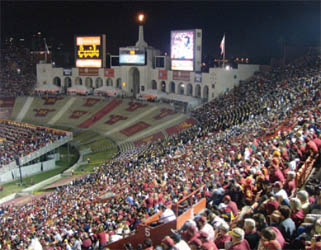- The L.A. Coliseum embarks on a series of technical improvements - with dramatic results.
- One of the ten largest college football stadiums in the country, The Los Angeles Memorial Coliseum is home to the USC Trojans, the six-time Pac 10 champion college football team from the University of Southern California. The Coliseum, with a
Six Meyer SB-3F sound field synthesis loudspeakers are mounted on each side of the main peristyle, along with six 700-HP subwoofers. capacity of over 92,000, operates under the Los Angeles Coliseum Commission, with a governing body comprised of representatives from the City of Los Angeles, the County of Los Angeles, and the State of California.
Last spring, the Los Angeles Coliseum Commission approved a series of improvements to the stadium in the form of incremental upgrades over the next five years. The upgrades, which began in May of 2008, include an overhaul of video and audio production services inside the stadium for the purpose of providing enhanced multimedia services to the capacity crowds in attendance.
According to Leo Caudillo, IT director at Los Angeles Memorial Coliseum, the upgrades were finished just a week before the September 13, 2008 Trojans' home season opener versus Ohio State, which USC won 35-3. Caudillo says the Coliseum was in desperate need of a technology update. "We spent about $1.3 million back in 1997, and that was on an all-analog system. There were an old CRT screens that had issues with cooling, and modules were popping out."

production platform that includes a switcher, character generator, clip stores, still stores, monitoring, and a file-based server architecture to streamline the production workflow.
"The Slate HD provides a lot of flexibility," Caudillo says. "It helps with computer integration and allows for multiple levels of control. With it, we are able to have a double broadcast, one to the internet and one to the videoboard. Slate HD includes 32 inputs, 16 of which are used to connect a variety of cameras, audio, and source equipment such as HD and SDI players for replay purposes during games. Six digital video effects, which are built into the Slate HD, allow for the production of multiwindow displays on each screen and the integration of XML data crawls for scores and other text-based information."
"The DVE's work very well for providing other game scores and video replays," according to Caudillo. The dual-format digital production workflow can accommodate the two new display screens installed by Sign Methods of Los Angeles, including a 40-foot by 45-foot Optec LED display board, with 16mm resolution for 4x3 SDI; and a 215-foot LED panel at the west end that can accommodate 16x9 HD video.
"Optec was about $400,000 less than their competitors, and with a better warranty," says Caudillo. According to Optec, each pixel is a separate replaceable module, so if a pixel fails or is damaged, rather than replacing an entire circuit board/module that usually consists of 64 or 256 pixels, each pixel module snaps in and out individually. This eliminates the typical "tile" effect that results when a large 16 x 16-pixel replacement module stands out from the surrounding modules because it doesn't match the existing display's brightness, due to variations in the degradation rate of the original modules versus the replacement module. Inside each pixel, there is an individual circuit controlling each LED lamp. With Optec's advanced controller system, a technician can control brightness/color shadings down to each LED lamp level. The result is better color mix, contrast, higher virtual resolution, and longer LED life.
Dual outputs from the Broadcast Pix Slate feed the video to PremierViewProHD-LED video scalers from Calibre UK for image re-sizing. The images are transported as DVI signals over fiber to the appropriate display screens. "That scaler, when we run composite cameras during the day, modifies the signal and looks great. You have a beautiful high def signal overall," says Caudillo.
Production contractors produce the video and audio during games as in the past, but without the lengthy set-up and breakdown times associated with bringing in external equipment. The production team can also log in to Slate remotely to integrate clips and other elements into the integrated server to set up a show, and then preview the show from an external location or inside the venue later after arriving at the stadium.
USC football games use a full production team, including four live camera operators and three control room operators; one director to operate the switcher and monitor the production, one technician to trigger clips and graphics, and one replay specialist working with external video sources.
On the audio end of the upgrade, Caudillo sounds equally enthusiastic about what has been brought in. "The old audio was very unsatisfactory. We had some old horns and subwoofers that were lacking in maintenance. There were bird droppings everywhere. And it was costing us $25,000 a game for equipment rental and labor just to do sound."
That's when Meyer Sound came in to supply the new stadium-wide sound system, which is operated from a separate Midas Venice 320 mixing board located in the same control room for USC football games. The showcase piece of the new system is the Meyer SB-3F, a self-powered loudspeaker incorporating a multichannel, highpower, class AB/H power amplifier and sophisticated control circuitry - all housed within the loudspeaker's cabinet, which dramatically simplifies setup and installation.
The new system, which was budgeted at a total of roughly $725,000, is tied into the Slate HD for integrated audio control during smaller events, such as international soccer games. A single operator can control the entire Slate HD system for smaller events, using robotic cameras for image acquisition and Broadcast Pix's Audio Follow Video feature to control the Meyer Sound system.
Matt Wunsch is a freelance writer and studio musician in Wakefield, RI. Got a comment? Contact us at AVT@nbmedia.com, and type the title of this article into the subject header.










